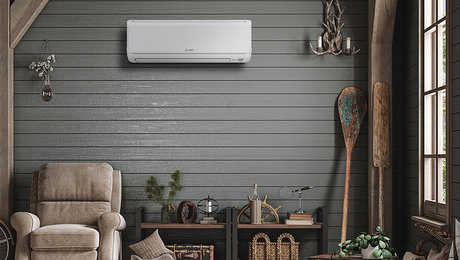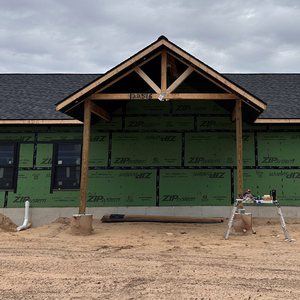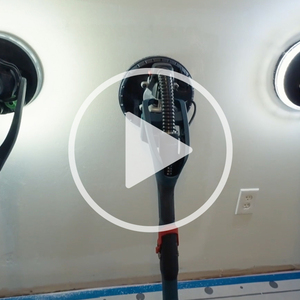I purchased a Bathroom window and neglected to order obscure glass. I tried to solve the problem with a spray on product but I wasn’t happy with the result so I tried the privacy film. I didn’t like that either. I could reorder the sash (which would be less work all round than replacing just the glass) but I thought I could try attacking the glass with a palm sander as a last resort. Any thoughts or is this just plain ridiculous?
Discussion Forum
Discussion Forum
Up Next
Video Shorts
Featured Story

Choosing the right heating and cooling system means finding the best fit for your home's size, layout, and climate—and balancing trade-offs in efficiency, comfort, and cost.
Related Stories
Highlights
"I have learned so much thanks to the searchable articles on the FHB website. I can confidently say that I expect to be a life-long subscriber." - M.K.
Fine Homebuilding Magazine
- Home Group
- Antique Trader
- Arts & Crafts Homes
- Bank Note Reporter
- Cabin Life
- Cuisine at Home
- Fine Gardening
- Fine Woodworking
- Green Building Advisor
- Garden Gate
- Horticulture
- Keep Craft Alive
- Log Home Living
- Military Trader/Vehicles
- Numismatic News
- Numismaster
- Old Cars Weekly
- Old House Journal
- Period Homes
- Popular Woodworking
- Script
- ShopNotes
- Sports Collectors Digest
- Threads
- Timber Home Living
- Traditional Building
- Woodsmith
- World Coin News
- Writer's Digest


















Replies
Try an internet search for "glass etching". I know there are chemicals you can use or sandblasting. Either one might be risky if we're talking insulated glass but probably no more then a sander would be. Some dishwasher detergents do a pretty good job of etching my drinking glasses. ;)
Blinds?
Just sayin' ;o)
An orbital sander will do the job....it goes slowly!
And the corners will have to be carefully worked by hand.
Sanding discs need to start at 50 grit and worked down to 150.
Sand blasting is faster, if you have the machine.
Liquid etching is by some pretty nasty chemicals.
Also you might consider installing a piece of figured/distressed/colored glass in a simple leaded frame over the existing IG with small clips or 3/m dble sided tape.
At one time we had a back door with a clear IG at ~24"x30" insert and we wanted some "walk-up privacy" and had a local artisan craft a stained glass insert which I held in with a secondary wooden frame. After the remodel 13 years ago, it still sets in a shed.
There are hobby stores that have "stained" sheet glass of large enough size to cut a single piece to fit the daylight opening in the sash....$$$
.............Iron Helix
You didn't like the frosted film so you may not like this idea either, but what about buying a pane of frosted glass cut to the exact dimension of the the clear pane and laying it right on top. You would need to be sure that it couldn't fall out, but glazier points and clear caulk should hold it.
There is a guy around here that calls himself a "glassmaster" maybe he will be along shortly.
The comment above about overlaying with frosted glass brought something to mind" Being that it is in a bathroom, how close is it to a bath tub or shower? If it is close, it needs to be tempered for safety reasons.
i had this a while back. so i took a pc of obscure/pebble plastic for a 2'x4' drop in ceiling light. cut it to fit the glass area,dabed a little silicone in each corner and stuck it on.
worked really well.
the older i get ,
the more people tick me off
I like it! It's even better than my frosted glass idea.
I did the same thing. The wife never realized that it was on there.
Only one small thing to watch: Use the ACRYLIC material. You can also get styrene, and it is a little cheaper. But it will yellow, whereas the ACRYLIC won't. (The orange box has both, I recently noted. And, as usual, the stock had been mixed up by the customers. So, watch your labels.)
you might know something about this...
You could try hide glue. I was surprised to learn that the higher strength hide glues will, because they shrink as they dry and because they grab so well, will actually tear off the surface of window glass. I have seen this done and the result was a surface that looked like snow flakes or ice crystals covering the surface. It is my understanding that this is ancient technology that has bee supplanted by newer chemical and mechanical processes. There was very good article in Fine Woodworking about a year ago that discusses the uses of hide glue and sources of supply.
Gee that brought back a memory of talking to a stained glass lady. But I didn't know it was hide glue. Just got some hide glue, so now the glass in by shop might get a hit.You can get Sodium Flouride from a hobby store. nasty stuff but it works.
I had 25 years in art glass work so I know some about it. Just to add some tidbits here:
Power sander will take FOREVER and look like cr^p.
Acid 'etching cream' is doable but is very difficult to apply evenly, and will more likely than not end up looking uneven anyway. Pain in the ####.
Horse hoof glue was the original type used to make glue chip glass, I am not sure if there is a modern substitute for this. The process requires the glass surface to be horizontal, the glue batch applied HOT, and it's a cr^p shoot for success if you do it on tempered.
LIGHT sandblasting can be done on tempered, but is generally a messy business. Maybe from outside?
What didn't you like about the particular film you had used? Sign shops now days use a vinyl that looks very much like etched glass.
Me, I'd avoid the hassle and reorder the sash or IGU, install it, then go have an espresso or beer. MUCH less hassle. New sash or lite couldn't be THAT much $.
My 3 cents.
Edited 9/11/2009 8:56 pm by kenhill3
What kenhill said.
$5 bag of silica sand from big box, $5 sandblaster from HF, set to go.
You can even cut a mask out of anything from an old inner tube to cardboard box and create patterns.
A friend of mine was an artist who made rather pricey sandblasted windows with various scenes on them. Something called a resist is applied to the glass to protect the area that was not to be sandblasted. Areas could be lightly sandblasted and then masked further to get various degrees of depth in the scene. She made it look easy but I assume that it wasn't - she had years of practice.
She used a big special box to trap and recycle the blast media. It is really messy and you will have sand all over if you don't confine it in some way. You will also need to be careful in masking the window frame to ensure that it remains pristine.
There are a number of how-to articles on the Internet if you search for them. A fairly simple minded explanation is at:
http://www.ehow.com/how_2240360_etch-glass-sandblasting.html
http://www.ehow.com/how_5155702_sandblast-glass.html
It's probably tempered, so blasting it has hazards. DO NOT use hide glue on it. Most likely it will causethe glass to shatter because it will make depressions too deep.
Sand blasting is the safest approach. BUT: it is not for the rank amateur. Getting a uniform frost on a large area is the most difficult job known & takes a lot of practice. I know - I once re didan entire church for a glass artist who tried it & wound up w/ tresh.
Sand blasting w/ white sand is dangerous - the dust created will give you a wicked case of silicosis if inhaled. The only really safe blast media is silicon carbide. You don't have the object in an enclosure, you lose all your media. expensive. When we re-did the church we left about 15 lbs of media in their brand new rugs. They'll be vacuuming gray dust out of them forever!
Find yourself a glass artist & ask about an etcher who can work on site. They exist. I can, & don't have to leave a lot of media behind. BTW: you want the frosting on the outside - inside tends to collect a lot of deposits & leaves a lot of water marks that are impossible to get off. There is a product you can put on it afterward that will protect against watermarks
Don ReinhardDon Reinhard
The Glass Masterworks
"If it scratches, I etch it!"
>> DO NOT use hide glue on it. Most likely it will causethe glass to shatter because it will make depressions too deep. <<
Are you saying that "hide glue" is the material that is normally used to chemically etch glass? Obviously I don't know the first thing about etching glass.
BTW - in another thread I attached a pic of our foyer door system and asked what you would do with it to obscure the glass and maybe a pic of something completed. I don't think you responded. Your thoughts would be greatly appreciated. The glass is tempered.
View Image
View Image
Matt: Sorry I never responded to the last msg on your front door. Will do so later this wknd.
Hide glue is used to make what is called "Glue chipped" glass - has a very rough texture that you cannot see through. You etch it first. put on the hide glue & put it in a desicator. the glue dehydrates, shrinks violently & literally rips the surface off the glass because it clongs to the etched rough surface. The chips go too deep in the glass & will disrupt the surface enough to cause TEMPERED glass to self destruct.
A front doo ris an easy project.
DonDon Reinhard
The Glass Masterworks
"If it scratches, I etch it!"